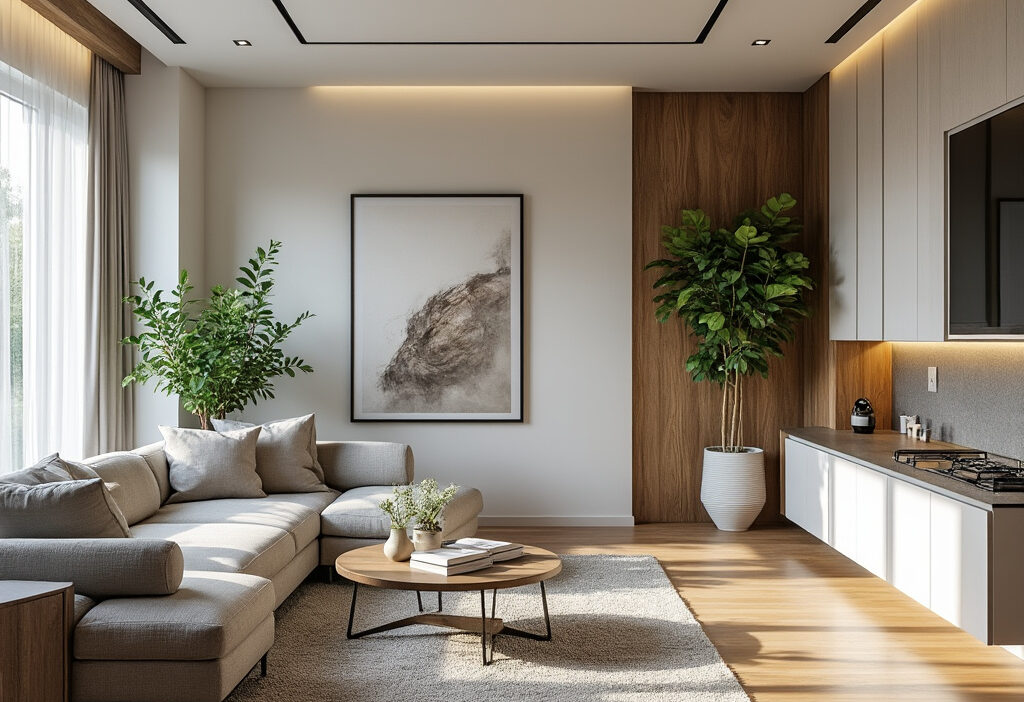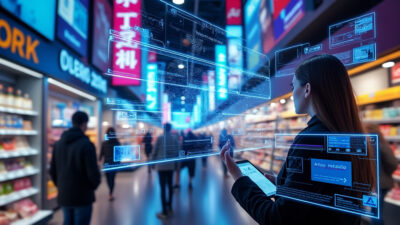Smarter Living: How Smart Home Technology Is Redefining Comfort, Security, and Efficiency in 2025
Smart home technology has transformed our living spaces into dynamic environments that adapt to our needs and preferences. In 2025, these advancements bring unparalleled comfort, heightened security, and remarkable energy efficiency. Through the lens of recent innovations, this article delves into how artificial intelligence, the Internet of Things (IoT), and sustainable designs are revolutionizing the way we live, promising a future where our homes are not just shelters, but intelligent partners in our daily lives.
The Rise of Smart Home Technology
The journey of smart home technology began in the mid-20th century with rudimentary automation systems, but it wasn’t until the late 1990s and early 2000s that the concept gained traction. Early adopters experimented with X10, a protocol allowing devices to communicate over power lines, but its limitations—slow speeds and interference—hindered mass adoption. The real turning point came with the proliferation of Wi-Fi and Bluetooth in the 2010s, enabling seamless wireless communication between devices. By 2020, the Internet of Things (IoT) had matured, transforming isolated gadgets into interconnected ecosystems.
The 2020s saw explosive growth, driven by advancements in edge computing and 5G networks, which reduced latency and improved reliability. Smart homes evolved from basic remote-controlled lighting to fully integrated systems capable of learning user behavior. Key breakthroughs included energy-efficient sensors, self-healing mesh networks, and standardized protocols like Matter, ensuring cross-brand compatibility. Societal shifts, such as remote work and aging populations, further accelerated adoption, as people sought safer, more efficient living environments.
By 2025, smart homes are no longer a luxury but a mainstream expectation. IoT has enabled devices—from refrigerators to HVAC systems—to communicate in real time, optimizing energy use and preemptively addressing maintenance issues. The rise of ambient computing has made technology fade into the background, creating intuitive, frictionless experiences. This seamless integration sets the stage for the next frontier: AI-powered automation, where systems don’t just respond but anticipate needs, redefining comfort and efficiency on an unprecedented scale.
AI-Powered Home Automation
AI-powered home automation has transformed modern living by turning static environments into dynamic, responsive spaces that adapt to individual needs. In 2025, artificial intelligence is no longer just an assistant—it has become the brain of the smart home, learning habits, predicting preferences, and optimizing efficiency without human intervention. Unlike earlier smart systems that relied on preset commands, today’s AI analyzes behavioral patterns to automate lighting, climate, and entertainment systems in real time. For instance, an AI-powered thermostat doesn’t just follow schedules—it adjusts temperatures based on occupancy, weather forecasts, and even personal comfort trends.
Voice control has also evolved beyond basic commands. AI-driven assistants now understand context, detect emotional tones, and execute multi-step tasks seamlessly. Instead of saying, “Turn off the lights,” users can now say, “I’m going to bed,” triggering a cascade of actions—dimming lights, locking doors, and activating security modes. These systems also integrate with smart appliances, enabling predictive maintenance. Refrigerators alert users before food expires, while washing machines diagnose potential malfunctions and schedule repairs autonomously.
The true power of AI lies in its ability to unify disparate devices into a cohesive ecosystem. Unlike the fragmented smart homes of the past, AI now orchestrates interactions between IoT-enabled gadgets, ensuring they work in harmony. This sets the stage for the next frontier: seamless IoT integration, where connectivity between devices becomes so intuitive that the home operates as a single, intelligent entity.
Seamless IoT Integration
The Internet of Things (IoT) has become the backbone of modern smart homes, enabling devices to communicate effortlessly and create a truly interconnected living space. In 2025, seamless IoT integration goes beyond simple connectivity—it orchestrates a symphony of synchronized operations that adapt to users’ needs in real time. Unlike standalone smart devices of the past, today’s IoT ecosystems leverage unified protocols like Matter to ensure compatibility across brands, eliminating fragmentation and enhancing reliability.
One of the most transformative aspects of IoT is its ability to unify disparate home environments. For instance, a morning routine can now involve a cascade of automated actions: smart blinds open as the thermostat adjusts to the optimal temperature, while the coffee maker starts brewing—all triggered by a single wake-up command. Similarly, security systems now integrate with lighting and cameras, activating motion-sensitive pathways that guide residents safely through the house at night.
The true power of IoT lies in its contextual awareness. Advanced sensors and edge computing allow devices to anticipate needs without explicit commands. A smart refrigerator can sync with a meal-planning app to suggest recipes based on inventory, while a laundry machine adjusts cycles based on fabric type detected via RFID tags. These interactions minimize manual input, making daily life more intuitive.
As IoT evolves, interoperability remains key. The shift toward decentralized networks, like mesh Wi-Fi and 5G, ensures robust connectivity even in larger homes. With AI-driven analytics working alongside IoT, as discussed in the previous chapter, the next frontier is predictive automation—where systems learn from behavioral patterns to optimize comfort, security, and efficiency. This sets the stage for the next chapter’s focus on energy management, where IoT’s real-time data collection plays a pivotal role in sustainability.
Advancements in Energy Efficiency
The rapid evolution of smart home technology in 2025 has brought groundbreaking advancements in energy efficiency, transforming how households manage and conserve power. With sustainability at the forefront, net-zero home solutions have emerged as a game-changer, enabling homes to produce as much energy as they consume. Solar panels, now more efficient and affordable, are integrated with smart inverters and battery storage systems, allowing homeowners to store excess energy and reduce reliance on the grid.
Intelligent energy management systems (IEMS) leverage AI to optimize energy usage in real-time. These systems analyze patterns in electricity consumption, adjusting heating, cooling, and lighting based on occupancy and weather conditions. For instance, smart thermostats now sync with occupancy sensors to lower HVAC usage in unoccupied rooms, while adaptive lighting dims or turns off when natural light is sufficient.
Another breakthrough is the rise of predictive load balancing, where IEMS anticipates peak demand periods and shifts non-essential appliance usage to off-peak hours, reducing strain on the grid and cutting utility costs. Smart appliances, such as refrigerators and washing machines, now operate during low-tariff periods without compromising convenience.
Moreover, blockchain-enabled energy trading platforms allow homeowners to sell surplus solar energy directly to neighbors, fostering community-based sustainability. These innovations not only shrink environmental footprints but also deliver tangible savings—studies show households using IEMS reduce energy bills by up to 30%.
As IoT integration continues to streamline device interoperability, these energy-efficient solutions work seamlessly with broader smart home ecosystems, setting the stage for even smarter, greener living. The next frontier—AI-driven security—builds on this foundation, ensuring homes are not only efficient but also safer than ever.
Revolutionizing Home Security
In 2025, AI-powered home security systems have evolved far beyond traditional alarms and cameras, integrating deep learning and contextual awareness to create a seamless safety net. Unlike earlier systems that relied on motion sensors or simple video analytics, today’s solutions leverage predictive algorithms to differentiate between routine activities—like a pet wandering the house—and genuine threats, such as an intruder attempting forced entry. These systems analyze behavioral patterns, ambient noise, and even facial recognition to assess risk in real time, minimizing false alarms while maximizing responsiveness.
One groundbreaking advancement is the adaptive response protocol, where the system doesn’t just alert homeowners but takes proactive measures. For instance, if an unauthorized entry is detected, smart locks can automatically engage, lights can simulate occupancy, and AI assistants can discreetly notify authorities with precise location data. Meanwhile, integration with energy-efficient systems—like those discussed in the previous chapter—ensures security measures don’t disrupt sustainability goals. For example, motion-activated security lighting now uses ultra-low-power LEDs powered by solar grids, aligning safety with eco-conscious design.
Privacy remains a cornerstone, with edge computing enabling data processing locally rather than in the cloud, reducing exposure to breaches. Homeowners can customize surveillance zones, ensuring cameras ignore private areas like bedrooms while monitoring high-risk points like entryways. As we transition to the next chapter, where biophilic design meets smart technology, it’s clear that security systems are no longer intrusive additions but harmonious elements of a holistic living environment—balancing safety, efficiency, and well-being.
Design Meets Technology
As smart home technology evolves in 2025, a fascinating convergence is taking place between biophilic design and intelligent systems, creating living spaces that seamlessly blend nature with cutting-edge innovation. Biophilic design, which emphasizes human connection to the natural world, is no longer just about materials and aesthetics—it’s being enhanced by smart technology to foster deeper well-being.
Smart lighting systems now mimic natural daylight cycles, adjusting color temperature and intensity to align with circadian rhythms, reducing eye strain and improving sleep quality. Voice-controlled indoor gardens and automated plant-care systems ensure greenery thrives effortlessly, while air purification systems monitor and adjust humidity and air quality in real time, emulating the freshness of a forest. Even soundscapes are curated—AI-driven acoustic systems can replicate the calming sounds of rain or birdsong, adapting to the time of day or the homeowner’s mood.
However, the challenge lies in integrating these technologies without disrupting biophilic principles. Over-reliance on screens or intrusive automation can detract from the organic experience. The solution? Invisible intelligence—sensors and controls that operate unobtrusively, responding to natural behaviors like movement or ambient light rather than requiring manual input. For example, smart glass windows tint dynamically to optimize natural light while reducing glare, and motorized shades adjust based on the sun’s position, all without user intervention.
This synergy between biophilic design and smart tech doesn’t just enhance comfort—it redefines how we experience our homes. By prioritizing subtle, nature-inspired automation, these systems create spaces that feel both futuristic and fundamentally human, setting the stage for the next evolution in home environments.
The Future of Work from Home
The rise of remote work has transformed homes into multifunctional hubs, and smart home technology in 2025 is at the forefront of this evolution. No longer just a place to unwind, the modern home must seamlessly transition between work and relaxation—a challenge smart systems are uniquely equipped to handle. Adaptive lighting systems, for instance, now mimic natural daylight cycles, reducing eye strain and boosting focus during work hours while shifting to warmer tones in the evening to promote relaxation. These systems integrate with wearable devices to adjust brightness and color temperature based on the user’s circadian rhythm, ensuring optimal conditions for both productivity and well-being.
Temperature control has also become more sophisticated, with AI-driven climate systems learning individual preferences and adjusting settings based on room occupancy and activity. A home office might stay slightly cooler to maintain alertness, while the living area warms up for evening comfort. Configurable furniture, powered by smart actuators, allows spaces to transform instantly—a desk retracting into the wall to make room for a yoga mat or a dining table expanding for collaborative meetings. Voice and gesture controls enable effortless adjustments, reducing the friction between work and leisure modes.
Security plays a crucial role in this ecosystem. Smart locks and surveillance systems provide peace of mind for remote workers, while AI-powered noise cancellation ensures virtual meetings remain uninterrupted. The convergence of these technologies creates a fluid environment where the boundaries between professional and personal life blur—without sacrificing efficiency or comfort. As remote work becomes the norm, smart homes are no longer just living spaces but dynamic ecosystems that adapt to the rhythms of modern life.
Personalization and User Experience
In 2025, smart home technology has transcended basic automation, evolving into a deeply personalized ecosystem that adapts to individual lifestyles. Unlike the work-from-home optimizations discussed earlier, which focus on productivity, this chapter explores how AI-driven personalization tailors living spaces to enhance comfort, leisure, and emotional well-being.
Ambient Intelligence now learns from user behavior, adjusting lighting, temperature, and even scent diffusion based on real-time biometric feedback. For instance, smart systems analyze sleep patterns and gradually dim lights while lowering room temperature to prepare the body for rest. Morning routines are equally refined—blinds open at the optimal time, and coffee machines start brewing as soon as motion sensors detect wakefulness.
Entertainment systems have also become hyper-personalized. Voice-controlled assistants curate playlists, suggest movies, or even adjust surround sound profiles based on mood indicators like voice tone or heart rate. Immersive environments can transform a living room into a virtual beach or a cozy library with a single command, leveraging augmented reality and spatial audio.
Beyond convenience, personalization extends to health. Smart mirrors analyze skin conditions and suggest skincare routines, while refrigerators track nutritional intake and recommend meal plans. These features integrate seamlessly with wearable devices, creating a holistic health ecosystem.
However, this level of customization relies on vast data collection, a topic that segues into the next chapter’s discussion on privacy risks. While smart homes now feel like intuitive extensions of their occupants, the balance between personalization and data security remains a critical challenge. The future lies in systems that deliver tailored experiences without compromising user trust.
The Challenges ahead
While smart home technology has revolutionized personalization and user experience, its rapid advancement brings significant challenges that must be addressed to ensure sustainable adoption. Privacy and data security remain top concerns, as interconnected devices collect vast amounts of personal data—ranging from daily routines to biometric information. Unauthorized access, data breaches, or misuse by third parties could expose users to risks like identity theft or surveillance. Solutions include stronger encryption protocols, decentralized data storage, and stricter regulations mandating transparent data usage policies. Manufacturers must prioritize privacy-by-design, ensuring devices only collect necessary data and grant users full control over their information.
Another pressing issue is the digital divide, where lower-income households risk being excluded from smart home benefits due to high costs or lack of technical literacy. This could deepen societal inequalities, as smart homes become the norm. Affordable modular systems, government subsidies, and community-driven tech education programs can help bridge this gap.
Interoperability is another hurdle—proprietary ecosystems often lock users into single brands, limiting flexibility. Industry-wide standardization, open-source platforms, and universal protocols like Matter could foster seamless integration across devices.
Lastly, over-reliance on automation raises concerns about system failures or cyberattacks disabling critical home functions. Redundant backup systems, offline operation modes, and AI-driven anomaly detection can mitigate these risks.
Addressing these challenges is crucial to ensure smart homes enhance lives without compromising security or inclusivity. As we look toward future innovations, resolving these issues will pave the way for a more equitable and resilient smart living ecosystem.
Looking to the Future
Looking beyond 2025, smart home technology is poised to transcend its current capabilities, evolving into an even more seamless and intuitive extension of daily life. The integration of advanced AI and IoT ecosystems will push homes toward near-autonomous operation, where predictive algorithms learn from occupants’ habits, preferences, and even emotional states to optimize comfort and efficiency. Imagine a home that not only adjusts lighting and temperature but also anticipates needs—like brewing coffee when it senses you’re waking up or dimming lights when it detects stress.
Sustainability will drive innovation, with homes becoming active participants in energy ecosystems. Self-healing materials and biophilic design will merge with smart systems, enabling walls that regulate insulation dynamically or windows that tint based on solar intensity. Energy grids will interact directly with homes, allowing them to store and share renewable energy autonomously, reducing reliance on traditional utilities.
The concept of the home as a living entity will deepen, with ambient computing creating environments that respond to voice, gesture, or even thought. Brain-computer interfaces (BCIs) could enable control without physical interaction, while augmented reality (AR) overlays turn walls into interactive displays. Privacy and security, addressed in earlier chapters, will evolve alongside these advancements, with decentralized AI and blockchain ensuring data integrity without sacrificing convenience.
Finally, the line between home and community will blur. Smart neighborhoods will emerge, where homes communicate to optimize shared resources, from traffic flow to emergency response. The future isn’t just about smarter homes—it’s about adaptive ecosystems that redefine how we live, interact, and coexist with technology.

Conclusions
As we embrace 2025, smart home technology continues to evolve, pushing the boundaries of comfort, security, and efficiency. With AI and IoT at the helm, our homes have become more responsive and integrated into our daily lives than ever before. Looking ahead, we can expect further innovations that will deepen our connection to our living spaces, making them not just more intelligent, but also more in tune with our environmental responsibilities and personal preferences.



